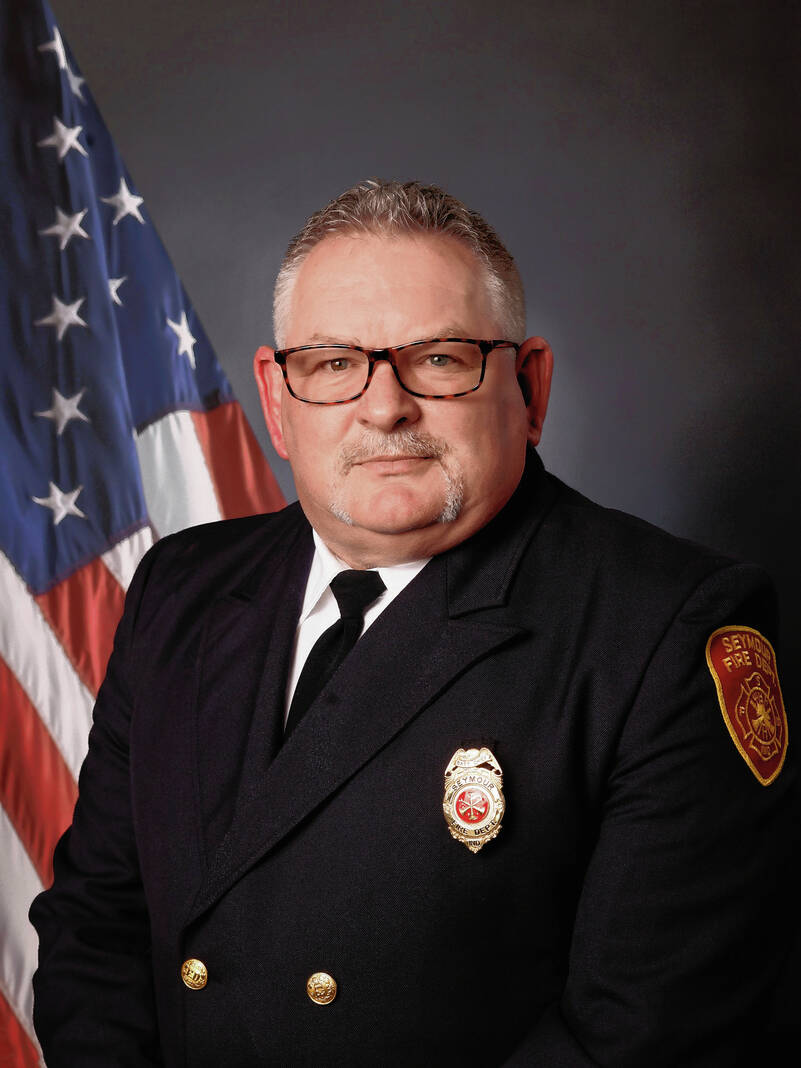
Seymour Fire Department Capt. Jason O’Neal, left, and Battalion Chief Cory Acton work together during a hazardous material exercise Aug. 9 involving a train derailment during the Oktoberfest in downtown Seymour.
Seymour Fire Department photo

Roll
For emergency responders, it’s important to have a plan of action in even the worst-case scenarios.
The Seymour Fire Department and other emergency response departments felt their worst-case scenario would be a train derailment during one of the busiest events in downtown Seymour, the Oktoberfest.
SFD Assistant Chief Eric Roll, Battalion Chief Cory Acton, Capt. Jason O’Neal and other emergency responders participated in a hazardous material exercise Aug. 9. The exercise was organized by Louisville and Indiana Railroad to see how they would handle an emergency incident of that magnitude.
“We have at least one of these hazmat exercises per year with our local emergency planning committee, and they have an exercise of this magnitude every three years,” said Roll, who was the incident commander during the exercise.
Roll was responsible for all actions that would be taken in an emergency incident. He said an incident commander develops objectives, action plans and has the responsibility for all of the people involved.
“Every run (emergency) we respond to, no matter what the situation is, someone will be incident commander,” he said.
Roll said incident commanders could be either senior firefighters or line officers who are trained under the National Incident Management System as part of the Incident Command System.
For Roll, being in the hot seat and calling the shots was a new experience, one that came with challenges he was ready to overcome.
“The biggest challenge for me was getting into the mindset of being the one that is totally in charge of an incident of this magnitude,” he said. “I was recently promoted to assistant chief just this past July, so I catch myself still in the mindset of being a line officer working instead of being the one that is in charge.”
Roll said they try to make the exercises as realistic as possible, so they involved one of the local dispatchers to send out the first responders on the scene. Those who were dispatched to the scene first were Acton and O’Neal, who performed initial tactical actions on scene.
“An incident of this magnitude would involve a range of organizations,” he said. “Even though the scenario was made to be difficult and have problems, each department did a superior job.”
Representatives from private specialized hazmat companies, Schneck Medical Center, Seymour Department of Public Works, Columbus Fire Department, Redding Township Volunteer Fire Department, Indiana Department of Homeland Security, Indiana Department of Transportation, Louisville and Indiana Railroad and several other departments were involved as the incident went on.
Roll said one of their biggest and challenging tasks was how to handle evacuating a large magnitude of people in downtown Seymour and the surrounding area. Along with the evacuation, emergency responders also had to consider stopping incoming traffic into Seymour.
Not only did the emergency responders think about how the magnitude of people and vehicular traffic would affect the situation, but they also considered many other factors that could affect the incident. The time of day, weather, location, initial response, equipment and information about the train derailment were just a few other considerations that would be in play during a hazmat incident, Roll said.
“As a line officer or being incident commander, I have kept Murphy’s Law in the back of my mind, ‘Anything that can go wrong will go wrong,’” he said. “All factors must be taken into consideration to better the outcome you are looking for.”
Roll said each department participating in this exercise will be better prepared when and if a situation was to arise where all hands would be needed on deck.
“We have a strong working relationship with Louisville and Indiana Railroad. They never hesitate to help with any training scenarios we would like to do,” he said. “Jeremy Kramer, vice president of the railroad, is very involved with working in our county’s local emergency planning committee.”
Roll said the railroad company will provide training opportunities to any department that requests it.
For fire department training, the railroad can offer two special train units, one that carries all different kinds of chemicals and petroleum products and the other is made for self-contained breathing apparatus training where firefighters have to crawl through with airpacks on to overcome different obstacles.
At the end of the exercise, Roll said he was pleased with how each department worked together.
“I believe each organization that was involved in this training did an excellent job,” he said. “It will benefit each department so they can go back and train on parts of the incident they were involved in.”
While emergency responders never hope to encounter a worst-case scenario, it is a vital part of making sure the community is safe.
